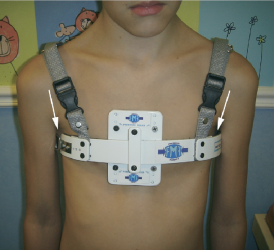Pectus Carinatum (pigeon chest ): Difference between revisions
Ahmed Nassef (talk | contribs) (Created page with "{{subst:Condition}}") |
m (Lucinda hampton moved page Pectus carinatum ( pigeon chest ) to Pectus Carinatum (pigeon chest ): corrected spelling) |
||
| (23 intermediate revisions by 5 users not shown) | |||
| Line 2: | Line 2: | ||
'''Original Editor '''- Your name will be added here if you created the original content for this page. | '''Original Editor '''- Your name will be added here if you created the original content for this page. | ||
''' | '''Top Contributors''' - {{Special:Contributors/{{FULLPAGENAME}}}} | ||
</div> | </div> | ||
== | == Introduction == | ||
[[File:PC.jpg|thumb|Pectus Carinatum<ref>Shamberger RC, Welch KJ. Surgical correction of pectus carinatum. Journal of pediatric surgery. 1987 Jan 1;22(1):48-53.</ref>]]Pectus carinatum (pigeon chest) refers to a chest wall deformity in which the [[sternum]] protrudes anteriorly. It is less common than pectus excavatum. It affects nearly 1 in 1000 teens, and early identification allows for more noninvasive treatment options.<ref name=":0">McHam B, Winkler L. Pectus Carinatum (Pigeon Chest). Available:https://www.ncbi.nlm.nih.gov/books/NBK541121/ (accessed 27.9.2022)</ref> | |||
== Etiology == | |||
The precise etiology of pectus carinatum is unknown, however most consider both pectus carinatum and pectus excavatum to be due to defective elongated growth of the [[Ribs|costal cartilage]]. A [[Genetics and Health|genetic]] element is suggested by the significant portion of patients with a family history of a chest wall defect or deformity. In about 25% of cases of pectus carinatum, the patient has a family member with the condition.<ref name=":0" /><ref name=":1">Radiopedia Pectus Carinatum Available:https://radiopaedia.org/articles/pectus-carinatum (accessed 27.9.2022)</ref> | |||
Pectus carinatum is generally a solitary, non-syndromic abnormality. However, the condition may be present in association with other syndromes: | |||
* [[Scoliosis]] (common) | |||
* Cyanotic [[Congenital Heart Disease|congenital heart disease]] (uncommon) | |||
* [[Marfan Syndrome|Marfan syndrome]].<ref name=":1" /> | |||
== Clinical Presentation == | == Clinical Presentation == | ||
Patients may present with [[dyspnoea]] and [[Physical Activity and Exercise Prescription|exercise]] intolerance. Some studies have shown an association with [[asthma]] or [[Chronic Bronchitis|chronic bronchitis]] in up to 16.4% of patients.<ref name=":0" /><ref name=":1" /> | |||
== Diagnostic Procedures == | == Diagnostic Procedures == | ||
Diagnosis of pectus carinatum is made by visual inspection, with further details offered by lateral chest [[X-Rays|Xray]] or computed tomography ([[CT Scans|CT]]).<ref name=":0" /> | |||
== | == Management / Interventions == | ||
[[File:Brace.png|thumb|External brace for treatment of Pectus Carinatum<ref>Shamberger RC, Welch KJ. Surgical correction of pectus carinatum. Journal of pediatric surgery. 1987 Jan 1;22(1):48-53.</ref>]]Treatment of pectus carinatum falls into three categories: non-surgical bracing, surgical correction, or cosmetic concealment. Orthotic braces are the first option for treatment as acceptable results are often achievable.<ref name=":0" /> | |||
'''External bracing technique''' | |||
= | Braces are worn either under/over the patient’s clothing for between 14 and 24 hours per day, depending on the manufacturer and the severity of the chest wall protrusion. Braces are most effective when applied before the patient’s growth spurt and less effective after age 19 due to changes in the flexibility of the chest wall. Unfortunately due to the lengthy treatment period (often months to years) and slow progression of the correction, many patients do not like this option.<ref name=":0" /> | ||
'''Surgical:''' For patients with severe pectus carinatum, surgery may be necessary. However bracing could and may still be the first line of treatment. Some severe cases treated with bracing may result in just enough improvement that the patient is happy with the outcome and may not want surgery afterward.<ref>Robicsek F, Watts LT, Fokin AA. Surgical repair of pectus excavatum and carinatum. Semin Thorac Cardiovasc Surg. 2009;21(1):64-75. doi:10.1053/j.semtcvs.2009.03.002</ref>{{#ev:youtube|v=6iujiHWnQRE|400}}<ref>Maimonides Medical Center. Nuss Procedure for Pectus Excavatum. Available from:https://www.youtube.com/watch?v=6iujiHWnQRE [last accessed 27/8/2020]</ref> | |||
'''Other options:''' After adolescence, some men and women use bodybuilding as a means to hide their deformity. Some women find that their breasts, if large enough, serve the same purpose. Some plastic surgeons perform breast augmentation to disguise mild to moderate cases in women. Bodybuilding is suggested for people with symmetrical pectus carinatum. | |||
=== Physiotherapy === | |||
[[File:Yoga DS.jpg|thumb|Yoga]] | |||
Postural correction and strengthening chest and [[Back Muscles|back muscles]] may help with pectus excavatum as bad [[posture]] is implicated in the severity and prominence of the condition. | |||
The aim of exercises in this condition is to: | |||
# Loose and lengthen tight or contractured tissues. | |||
# Improve chest wall and spinal mobility | |||
# [[Strength Training|Strengthen muscles]] needed for chest expansion and elevation | |||
# Restore and maintain normal posture | |||
# Improve and maintain [[Lung Compliance|lung compliance]] | |||
Exercises such as the use of dumbbells to strengthen the [[Latissimus Dorsi Muscle|latissimus dorsi]] and [[rhomboids]] using a pose termed dumbbell rear delt fly, [[Yoga]] poses such as superman (Lie on a mat with your stomach and arms extended and forehead resting on the ground, inhale then lift your head, legs, and arms, hold for 5seconds and then gently relax); seated twist (Sitting straight, engage your core and arms in forward flexion with/without weight in both hands, inhale and as you exhale, perform a lateral rotation to the right, hold for 5seconds and while inhaling relax; do for the other side and repeat for about 10 times); Bow pose for improved chest expansion and deep breathing (Lie on a mat with your stomach with knees flexed, grab your ankles with your hands then inhale and lift your thighs off the floor while your shoulder blades pressing back to open your chest and your gaze forward; hold the pose for 15 seconds and repeat 2 times); Camel pose (In upright kneeling with your shins and the dorsum of your feet pressed to the ground, your hands at the back of your pelvis, lean back, aiming to drop your hands to your heels with your head dropped back and without losing the upright kneeling posture; hold the pose for about 15 seconds and repeat twice)<ref>Bubnis D. Healthline; 2016. Exercises to treat pectus excarvatum and improve strength. Available from:https://www.healthline.com/health/fitness-exercise/pectus-excavatum-exercises (accessed 31 August 2020)</ref> | |||
== References == | == References == | ||
<references /> | |||
[[Category:Conditions]] | |||
[[Category:Cardiopulmonary]] | |||
[[Category:Cardiopulmonary - Conditions]] | |||
[[Category:Paediatrics]] | |||
[[Category:Paediatrics - Conditions]] | |||
Latest revision as of 06:05, 27 September 2022
Original Editor - Your name will be added here if you created the original content for this page.
Top Contributors - Uchechukwu Chukwuemeka, Adam Vallely Farrell, Kim Jackson, Ahmed Nassef and Lucinda hampton
Introduction[edit | edit source]

Pectus carinatum (pigeon chest) refers to a chest wall deformity in which the sternum protrudes anteriorly. It is less common than pectus excavatum. It affects nearly 1 in 1000 teens, and early identification allows for more noninvasive treatment options.[2]
Etiology[edit | edit source]
The precise etiology of pectus carinatum is unknown, however most consider both pectus carinatum and pectus excavatum to be due to defective elongated growth of the costal cartilage. A genetic element is suggested by the significant portion of patients with a family history of a chest wall defect or deformity. In about 25% of cases of pectus carinatum, the patient has a family member with the condition.[2][3]
Pectus carinatum is generally a solitary, non-syndromic abnormality. However, the condition may be present in association with other syndromes:
- Scoliosis (common)
- Cyanotic congenital heart disease (uncommon)
- Marfan syndrome.[3]
Clinical Presentation[edit | edit source]
Patients may present with dyspnoea and exercise intolerance. Some studies have shown an association with asthma or chronic bronchitis in up to 16.4% of patients.[2][3]
Diagnostic Procedures[edit | edit source]
Diagnosis of pectus carinatum is made by visual inspection, with further details offered by lateral chest Xray or computed tomography (CT).[2]
Management / Interventions[edit | edit source]

Treatment of pectus carinatum falls into three categories: non-surgical bracing, surgical correction, or cosmetic concealment. Orthotic braces are the first option for treatment as acceptable results are often achievable.[2]
External bracing technique
Braces are worn either under/over the patient’s clothing for between 14 and 24 hours per day, depending on the manufacturer and the severity of the chest wall protrusion. Braces are most effective when applied before the patient’s growth spurt and less effective after age 19 due to changes in the flexibility of the chest wall. Unfortunately due to the lengthy treatment period (often months to years) and slow progression of the correction, many patients do not like this option.[2]
Surgical: For patients with severe pectus carinatum, surgery may be necessary. However bracing could and may still be the first line of treatment. Some severe cases treated with bracing may result in just enough improvement that the patient is happy with the outcome and may not want surgery afterward.[5]
Other options: After adolescence, some men and women use bodybuilding as a means to hide their deformity. Some women find that their breasts, if large enough, serve the same purpose. Some plastic surgeons perform breast augmentation to disguise mild to moderate cases in women. Bodybuilding is suggested for people with symmetrical pectus carinatum.
Physiotherapy[edit | edit source]
Postural correction and strengthening chest and back muscles may help with pectus excavatum as bad posture is implicated in the severity and prominence of the condition.
The aim of exercises in this condition is to:
- Loose and lengthen tight or contractured tissues.
- Improve chest wall and spinal mobility
- Strengthen muscles needed for chest expansion and elevation
- Restore and maintain normal posture
- Improve and maintain lung compliance
Exercises such as the use of dumbbells to strengthen the latissimus dorsi and rhomboids using a pose termed dumbbell rear delt fly, Yoga poses such as superman (Lie on a mat with your stomach and arms extended and forehead resting on the ground, inhale then lift your head, legs, and arms, hold for 5seconds and then gently relax); seated twist (Sitting straight, engage your core and arms in forward flexion with/without weight in both hands, inhale and as you exhale, perform a lateral rotation to the right, hold for 5seconds and while inhaling relax; do for the other side and repeat for about 10 times); Bow pose for improved chest expansion and deep breathing (Lie on a mat with your stomach with knees flexed, grab your ankles with your hands then inhale and lift your thighs off the floor while your shoulder blades pressing back to open your chest and your gaze forward; hold the pose for 15 seconds and repeat 2 times); Camel pose (In upright kneeling with your shins and the dorsum of your feet pressed to the ground, your hands at the back of your pelvis, lean back, aiming to drop your hands to your heels with your head dropped back and without losing the upright kneeling posture; hold the pose for about 15 seconds and repeat twice)[7]
References[edit | edit source]
- ↑ Shamberger RC, Welch KJ. Surgical correction of pectus carinatum. Journal of pediatric surgery. 1987 Jan 1;22(1):48-53.
- ↑ 2.0 2.1 2.2 2.3 2.4 2.5 McHam B, Winkler L. Pectus Carinatum (Pigeon Chest). Available:https://www.ncbi.nlm.nih.gov/books/NBK541121/ (accessed 27.9.2022)
- ↑ 3.0 3.1 3.2 Radiopedia Pectus Carinatum Available:https://radiopaedia.org/articles/pectus-carinatum (accessed 27.9.2022)
- ↑ Shamberger RC, Welch KJ. Surgical correction of pectus carinatum. Journal of pediatric surgery. 1987 Jan 1;22(1):48-53.
- ↑ Robicsek F, Watts LT, Fokin AA. Surgical repair of pectus excavatum and carinatum. Semin Thorac Cardiovasc Surg. 2009;21(1):64-75. doi:10.1053/j.semtcvs.2009.03.002
- ↑ Maimonides Medical Center. Nuss Procedure for Pectus Excavatum. Available from:https://www.youtube.com/watch?v=6iujiHWnQRE [last accessed 27/8/2020]
- ↑ Bubnis D. Healthline; 2016. Exercises to treat pectus excarvatum and improve strength. Available from:https://www.healthline.com/health/fitness-exercise/pectus-excavatum-exercises (accessed 31 August 2020)







